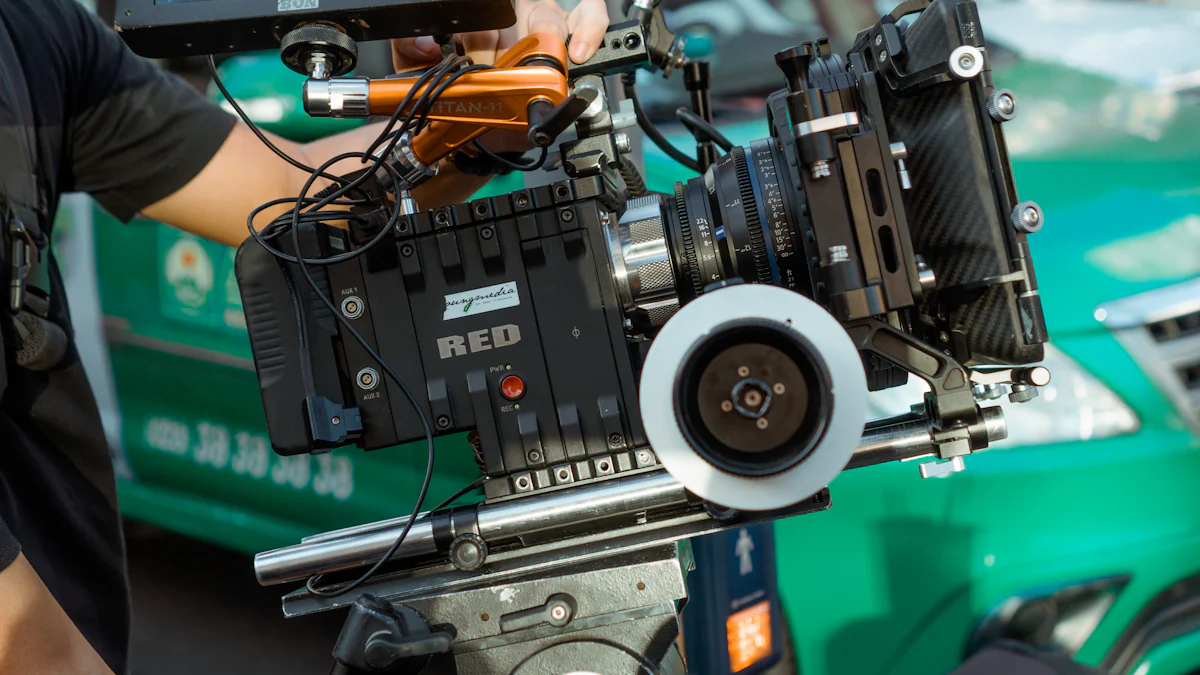Cinematography
Top Tips for Depth of Field in Cinematography
By
Alex Darke
July 22, 2024 11:31 pm
Depth of field cinematography refers to the range of distance within a shot that appears acceptably sharp. This concept plays a crucial role in storytelling by allowing filmmakers to control focus areas, directing audience attention and enhancing visual style. A shallow depth of field cinematography isolates the subject from the background, creating a sense of depth and guiding the viewer’s focus. Conversely, a deep depth of field cinematography keeps both the foreground and background in focus, providing a broader sense of the environment. Understanding these techniques can elevate the visual impact of any film.
Understanding Depth of Field in Cinematography

Image Source: pexels
Definition and Basics
What is Depth of Field?
Depth of field cinematography refers to the range within a shot that appears acceptably sharp. This range can vary significantly, influencing the visual impact of a scene. A shallow depth of field creates a narrow focus area, while a deep depth of field keeps more of the scene in focus.
How it Works in Cinematography
Depth of field cinematography works by manipulating the camera's aperture, focal length, and distance from the subject. Filmmakers use these elements to control which parts of the image appear sharp. Adjusting these factors allows for creative storytelling and visual emphasis.
Types of Depth of Field
Deep Depth of Field
Deep depth of field cinematography keeps both the foreground and background in focus. This technique provides a comprehensive view of the scene. Filmmakers often use deep depth of field to establish context and environment. For example, Orson Welles used deep depth of field in Citizen Kane to emphasize the sprawling estate of Charles Foster Kane. This technique showed Charles as a child playing in the background while his parents sold him to high society.
Shallow Depth of Field
Shallow depth of field cinematography isolates the subject from the background. This technique creates a sense of depth and guides the viewer’s focus to specific elements. Filmmakers achieve this effect by using a longer lens with a wider aperture and getting close to the subject. Shallow depth of field can enhance emotional impact and highlight important details.
Factors Affecting Depth of Field
Aperture
How Aperture Size Influences Depth of Field
Aperture size plays a crucial role in determining depth of field. A wider aperture (lower f-stop number) results in a shallower depth of field. This technique isolates the subject from the background, creating a focused area. Conversely, a smaller aperture (higher f-stop number) increases the depth of field. This setting keeps more of the scene in focus, providing a comprehensive view.
Practical Examples
Filmmakers often use wide apertures to create intimate scenes. For instance, a close-up shot of a character's face with a blurred background emphasizes emotions. On the other hand, landscape shots benefit from smaller apertures. This setting ensures that both the foreground and background remain sharp, capturing the entire environment.
Focal Length
Impact of Different Focal Lengths
Focal length significantly impacts depth of field. Longer focal lengths (telephoto lenses) produce a shallower depth of field. This effect brings attention to specific elements within the frame. Shorter focal lengths (wide-angle lenses) result in a deeper depth of field. This technique captures more details across the scene.
Choosing the Right Focal Length
Selecting the appropriate focal length depends on the desired visual outcome. Use longer focal lengths for portraits or detailed shots. This choice creates a pleasing background blur. Opt for shorter focal lengths for wide shots or scenes requiring extensive focus. This approach ensures that all elements within the frame remain sharp.
Distance from Subject
How Distance Affects Depth of Field
The distance between the camera and the subject also affects depth of field. Moving closer to the subject decreases the depth of field. This technique isolates the subject, making it stand out. Increasing the distance from the subject enhances the depth of field. This setting keeps more of the scene in focus.
Techniques for Managing Distance
To manage distance effectively, consider the scene's requirements. For intimate or detailed shots, position the camera closer to the subject. This approach creates a shallow depth of field. For scenes needing broader focus, increase the distance between the camera and the subject. This method ensures a deeper depth of field, capturing more details within the frame.
Practical Tips for Cinematographers

Image Source: pexels
Choosing the Right Aperture
Tips for Different Scenarios
Selecting the correct aperture depends on the scene's requirements. For intimate portraits, use a wide aperture (low f-stop). This setting creates a shallow depth of field, isolating the subject. For landscape shots, choose a small aperture (high f-stop). This choice ensures that both the foreground and background remain sharp.
Common Mistakes to Avoid
Avoid using a wide aperture in scenes requiring extensive focus. This mistake can result in blurred backgrounds or foregrounds. Also, avoid using a small aperture for close-up shots. This error can reduce the subject's emphasis. Always match the aperture setting to the scene's needs.
Using Focal Length Creatively
Techniques for Different Effects
Experiment with different focal lengths to achieve various effects. Use a telephoto lens for a shallow depth of field. This technique brings attention to specific elements within the frame. Opt for a wide-angle lens for a deep depth of field. This choice captures more details across the scene.
Case Studies
Consider the film The Grand Budapest Hotel. The director used wide-angle lenses to capture the hotel's intricate details. In contrast, The Revenant utilized telephoto lenses for intense close-ups. These choices enhanced the emotional impact of the scenes.
Managing Subject Distance
Practical Advice
Adjust the camera's distance from the subject to control depth of field. Move closer for a shallow depth of field. This technique isolates the subject. Increase the distance for a deeper depth of field. This setting keeps more of the scene in focus.
Examples from Famous Films
In Blade Runner 2049, the director used close camera distances for character-focused scenes. This approach created a shallow depth of field, emphasizing emotions. Conversely, Lawrence of Arabia featured wide shots with increased camera distances. This method provided a comprehensive view of the vast desert landscape.
Advanced Techniques
Combining Factors for Desired Effects
Balancing Aperture, Focal Length, and Distance
Mastering depth of field requires a balance of aperture, focal length, and distance. Adjusting the aperture size changes the depth of field. A wider aperture creates a shallow depth of field. A smaller aperture increases the depth of field.
Focal length also plays a significant role. Longer focal lengths produce a shallower depth of field. Shorter focal lengths result in a deeper depth of field.
Distance from the subject affects the depth of field as well. Moving closer decreases the depth of field. Increasing the distance enhances the depth of field.
Combining these factors allows filmmakers to achieve the desired visual effect. For example, using a wide aperture with a long focal length and close distance creates an intense focus on the subject. Conversely, a small aperture with a short focal length and increased distance captures more details within the scene.
Experimentation and Practice
Experimentation is key to mastering depth of field. Filmmakers should try different combinations of aperture, focal length, and distance. This practice helps understand how each factor influences the final image.
Regular practice also improves skills. Filmmakers should shoot various scenes with different settings. Analyzing the results helps identify what works best for specific scenarios.
Al Judge, an expert in photography, emphasizes the importance of diving into the technical aspects. Understanding how to manipulate depth of field using different camera settings can significantly enhance visual storytelling.
Post-Production Adjustments
Software Tools
Post-production offers additional tools for adjusting depth of field. Software like Adobe Photoshop and Lightroom provides options to enhance or modify depth of field. These tools allow filmmakers to fine-tune their images after shooting.
Using software tools can correct any issues that occurred during filming. For example, blurring backgrounds or sharpening specific elements can help achieve the desired effect.
Techniques for Enhancing Depth of Field
Several techniques can enhance depth of field in post-production. One method involves using the blur tool to create a shallow depth of field. This technique isolates the subject by blurring the background.
Another method uses the sharpen tool to increase depth of field. This technique ensures that both the foreground and background remain in focus.
Filmmakers can also use layer masks to apply selective adjustments. This approach allows for precise control over which parts of the image appear sharp.
Understanding these advanced techniques can elevate the visual impact of any film. Mastering depth of field requires a combination of technical knowledge and creative experimentation.
Understanding depth of field in cinematography enhances visual storytelling. Mastering aperture, focal length, and distance allows filmmakers to control focus creatively. Experimentation with different settings helps develop a keen eye for detail. Regular practice improves skills and builds confidence. Depth of field can transform ordinary scenes into visually compelling narratives. Filmmakers should embrace these techniques to elevate their craft. Mastery of depth of field leads to more impactful and engaging films.

About the Author
Alex Darke is an Emmy-winning filmmaker, founder of the production company Momentous and owner of Filmmaking Central.

Filmmaking Central is a cutting-edge e-learning company dedicated to empowering aspiring filmmakers and content creators worldwide. With a robust library of comprehensive courses, expert-led workshops, and interactive learning materials, Filmmaking Central provides students with unparalleled access to industry professionals and innovative tools. By fostering an online community of passionate learners and storytellers, the platform aims to inspire creativity, develop essential skills, and ultimately cultivate the next generation of visionary filmmakers.
CONTACT
📍Las Vegas, NV
☎️ +1 888 494 5107
📧 hello@filmmakingcentral.com
SOCIAL
A Momentous Company © Filmmaking Central, All Rights Reserved. Here's our cookie policy page with all sorts of fun stuff. You know, privacy policy, disclaimer, and terms kind of stuff. Go back to the homepage or check out our courses and subscribe to our YouTube channel. You can also see our anti-SPAM policy, DCMA notice, earnings disclaimer, and affiliate disclosure.
